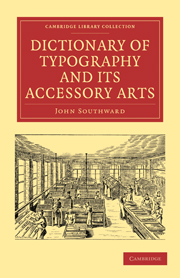Summary
WAREHOUSEMAN.—The person who has charge of the warehouse. It is his duty to keep an account of all paper received, to whom it is delivered for printing, the printed sheets received from the pressroom, and the quires sent out to the binder or publisher. It is also part of his business to direct the wetting of the paper, hanging the sheets to dry, taking down sheets from the poles, the filling in and pressing the sheets, counting them out and putting them away, etc.
WASHING A FORME.—Removing the ink from it after it has been printed. This is part of a pressman's duty, although in large establishments there are persons employed to do nothing else. The forme should be placed in the ley trough (q.v.), and the washer should take hold of the rim of the chase, and laying the forme gently down pour the ley gently upon it. He should then swing the trough a little so that the lye may spread over the face of the letter. Having done so he takes the ley brush and thoroughly brushes the liquid over the letter, furniture, quoins, and chase. The residue should then be allowed to run out, and the forme completely drenched with clean water to rinse away the ley. The forme is finally lifted ont and given over to the compositor.
WASTE.—The surplus sheets of a work, after the complete number of copies has been made up.
WATERMARKS.—Indentations made on paper in various shapes during the process of manufacture, the pulp of the paper being compressed by an engraved instrument called a dandy.
- Type
- Chapter
- Information
- Dictionary of Typography and its Accessory Arts , pp. 136 - 138Publisher: Cambridge University PressPrint publication year: 2010First published in: 1875



